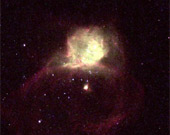درب التبانة ابتلعت مجرة أخرى!

9/1/2001
 توصل فلكيون أميركيون وأستراليون بعد رصدهم بقايا مجرة ابتلعتها مجرة درب التبانة إلى استنتاج يمكن أن يلقي الضوء على تكوين مجرتنا وهو أن درب التبانة تكونت من امتزاج عدد من المجرات قبل مليارات السنين.
توصل فلكيون أميركيون وأستراليون بعد رصدهم بقايا مجرة ابتلعتها مجرة درب التبانة إلى استنتاج يمكن أن يلقي الضوء على تكوين مجرتنا وهو أن درب التبانة تكونت من امتزاج عدد من المجرات قبل مليارات السنين.
وقدم الباحثون نتاج اكتشافهم إلى الجمعية الأميركية لعلم الفلك، وقالوا إن درب التبانة مجرة كبيرة إلى حد ما يعتقد أنها تكونت من امتزاج عدد من المجرات. غير أن العلماء لم يحددوا متى تم ذلك وكيف، ويقولون إن مجرة درب التبانة عبارة عن قرص من النجوم تتحرك في مدارات دائرية تقريبا, وهنالك انتفاخ من المرجح أن يكون قد تكون بعد ابتلاع مجرة صغيرة قبل عشرة مليارات سنة.
المصدر : الفرنسية